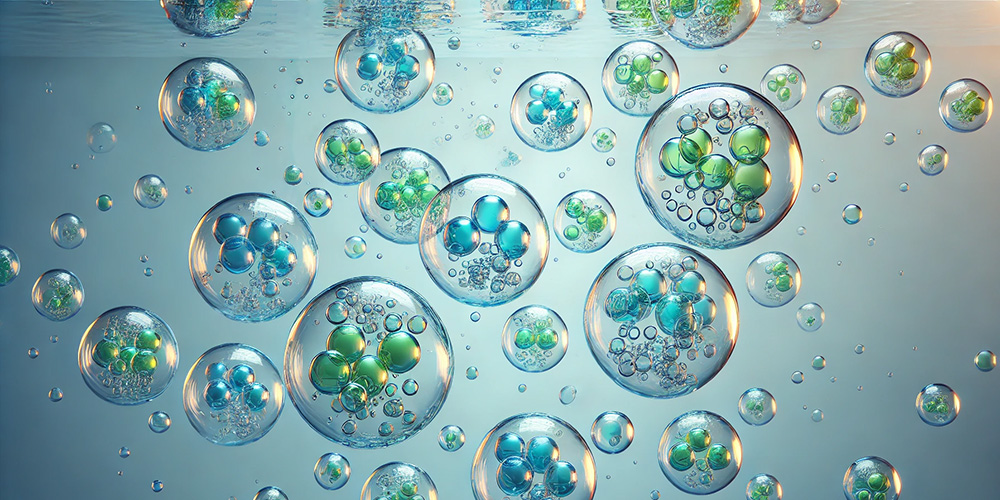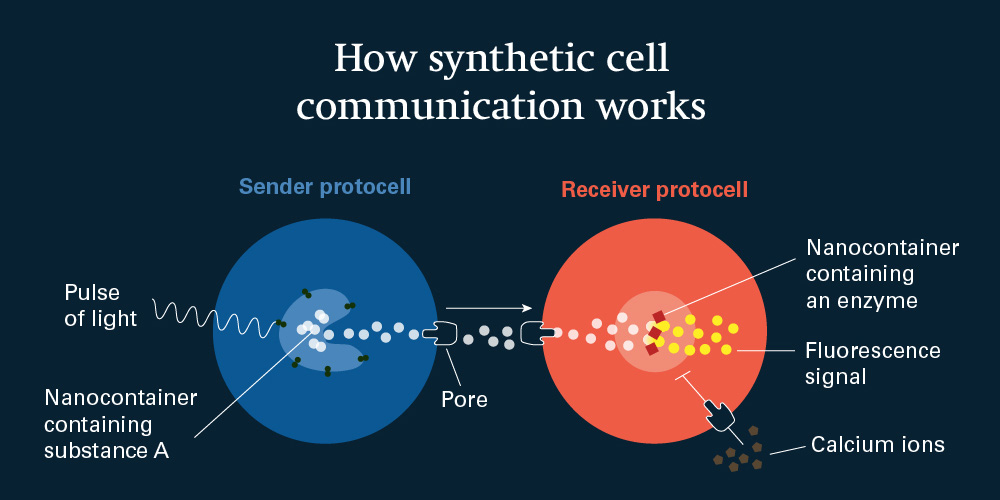Synthetic cells emulate natural cellular communication
A research team from the University of Basel has succeeded in synthesizing simple, environmentally sensitive cells complete with artificial organelles. For the first time, the researchers have also been able to emulate natural cell-cell communication using these protocells – based on the model of photoreceptors in the eye. This opens up new possibilities for basic research and applications in medicine.
12 November 2024 | Angelika Jacobs
Life is all about communication: from bacteria to multicellular organisms, living things rely on their cells’ ability to send, receive and process signals. For the first time, a research team has succeeded in emulating natural cell communication using synthetic cells. A team of researchers led by Professor Cornelia Palivan from the University of Basel and Nobel laureate Professor Ben Feringa from the University of Groningen reports on these findings in the scientific journal Advanced Materials.
Palivan and her colleagues carry out research into tiny containers made of polymers that they can load with specific molecules and open in a targeted manner. In their current project, the team goes one step further: “We constructed cell-sized microcontainers packed with specialized nanocontainers,” explains Palivan. This approach allows the researchers to simulate cells with cell organelles, creating a form of highly simplified synthetic cell also known as a protocell.
In their publication, the researchers describe a system of protocells made of polymers, biomolecules and other nanocomponents that is modeled on signal transmission in the retina of the eye. This system is made up of light-responsive protocells – the “senders” – on the one hand and receiver protocells on the other.
Light on
Within the sender cells are nanocontainers – essentially artificial organelles – whose membranes contain special light-sensitive molecules known as molecular motors. These allow the researchers to set communication between the two cells in motion using a pulse of light: when light reaches the sender cell, the light-sensitive molecules open the nanocontainers, releasing their contents – let’s call it substance A – into the sender cell's interior.
Substance A can then leave the sender cell through pores in its polymer shell before reaching the receiver cell via the fluid surrounding the protocells. Then substance A enters the receiver cells – again via pores – where it encounters artificial organelles harboring an enzyme. In turn, this enzyme converts substance A into a fluorescence signal, and the resulting glow tells researchers that signal transmission between sender and receiver has worked.
Calcium ions to dim fluorescence signal
In the photoreceptors of the retina that served as a model, calcium ions also play an important role, dampening the transmission of stimuli to the postsynaptic cells so that the eye can become accustomed to bright light. Similarly, the researchers designed the artificial organelles of the receiver cells in such a way that they react to calcium ions and the conversion of substance A into a fluorescence signal can be dampened.
Basis for synthetic tissue
“Using an external pulse of light, we succeeded in triggering an organelle-based signal cascade and modulating it with calcium ions. Producing a temporally and spatially controllable system based on the model of natural cell communication is a novelty,” says Palivan.
The researchers’ development sets the stage for synthetically emulating more complex communication networks of living cells – and thus for gaining a better understanding of them. There is also the possibility of creating communication networks between synthetic and natural cells and therefore of developing an interface between them. In the long term, this could pave the way for therapeutic applications with a view to treating diseases, for example, or to developing tissue with synthetic cells.
Original publication
Lukas Heuberger, Maria Korpidou, Ainoa Guinart, Daniel Doellerer, Diego Monserrat López, Cora-Ann Schoenenberger, Daela Milinkovic, Emanuel Lörtscher, Ben L. Feringa, Cornelia G. Palivan
Photoreceptor-like Signal Transduction Between Polymer-Based Protocells
Advanced Materials (2024), doi: 10.1002/adma.202413981




